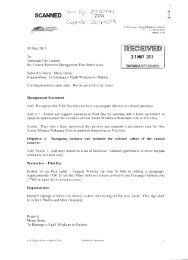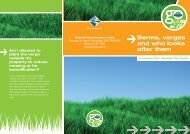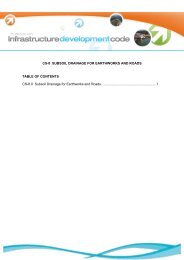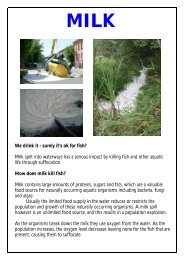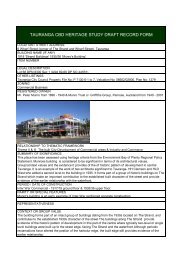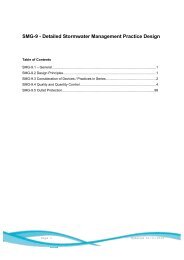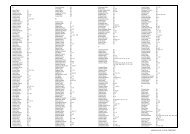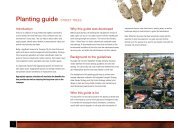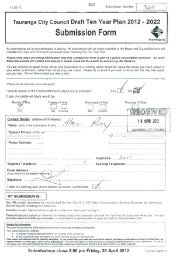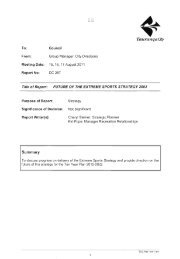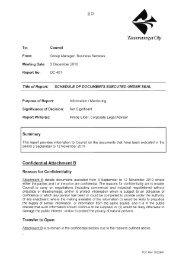tauranga cbd heritage study draft record form - Tauranga City Council
tauranga cbd heritage study draft record form - Tauranga City Council
tauranga cbd heritage study draft record form - Tauranga City Council
Create successful ePaper yourself
Turn your PDF publications into a flip-book with our unique Google optimized e-Paper software.
The Royal Arcade is one of the earliest commercail buildings in central <strong>Tauranga</strong>. It <strong>form</strong>s part of an intact<br />
group of 1920s and 30s buildings on the east side of the road which contribute to the established character<br />
of the street.<br />
DIVERSITY<br />
The Rotyal Arcade is one of few buildings in <strong>Tauranga</strong>'s CBD which date from the early 1920s and<br />
therefore contributes to the diversity of the built fabric.<br />
FRAGILITY OR VUNERABILITY<br />
ARCHAEOLOGICAL QUALITIES<br />
In<strong>form</strong>ation/Reseach/Recognition or Protection<br />
ARCHITECTURAL QUALITIES<br />
Style or type/Design<br />
The Royal Arcade is designed in a simple Classical style with pilasters dividing the facade into two bays. A<br />
parapet with balusters and a central curved pediment <strong>record</strong>ing the date of the building originally capped<br />
the facade. (The parapet was removed several years ago.) The facade has a textured plaster finish a small<br />
cornice supported on dentils, window architraves have quoin blocks, while the pilasters imitate textured<br />
ashlar stonework. The style and detail on the facade of the Royal Arcade are very similar to the building<br />
also built by Johansin on the corner of Spring and Willow Streets , which still remains.<br />
Designer or builder<br />
The Royal Arcade was built by Karl Johanson, who is also thought to have been responsible for its<br />
design.Karl Johansen is responsible for building a number of buildings in central <strong>Tauranga</strong> including the<br />
Royal Arcade, the Northern Star building and the building on the corner of Willow and Spring Street.<br />
Construction<br />
An early photograph shows that the building is constructed of concrete blockwork, plastered. The façade<br />
incorporates blocks with a roughened outer surface in imitation of stone. These are possibly a product<br />
called " Miracle Blocks" which were manufactured in America and publicised in the Progress magazine<br />
around the 1910s.Blockmaking machines capable of producing a range of finishes including stonelike<br />
blocks were also advertised in Progress around the same time.<br />
HISTORIC QUALITIES<br />
Historic Pattern<br />
The Royal Arcade was built in 1922 by Karl Johanson who built a number of buildings in central <strong>Tauranga</strong><br />
including the Northern Star Building (5864 Devonport Road) and the building at 136 Willow Street(on the<br />
corner of Spring Street, which is very similar in design to the Royal Arcade).The Johanson family appear to<br />
have arrived in <strong>Tauranga</strong> in 1910. The Royal Arcade was first leased by Mr. E A Entwhistle, cash grocer<br />
from Manchester, England. On 31 August 1933 Henry Graham and Harold Johanson (son of Karl) went<br />
into partnership and took over Entwhistle’s lease (he retired due to ill health). J H Graham & Co was the<br />
first firm “to advertise on the air”. Charles Cameron, who had radio shop next door erected a loud speaker<br />
above the verandah and J H Graham advertised “Oak specials” – a free money box, an old pound tin with<br />
a slot in it – with every purchase of an Oak product. The volume was so loud it could be heard “all over<br />
town and as far away as Pillons Point. Complaints came in thick and fast from other businesses on<br />
Devonport Road, the mayor, chamber of commerce and the police.”<br />
The first businesses in <strong>Tauranga</strong> were established along The Strand and Wharf Street. Devonport Road<br />
initially contained a mix of residential and small scaled business premises, with the businesses mostly<br />
clustered at the junction with Spring Street and The Strand. This gradually changed, with residential<br />
dwellings disappearing from the town centre.The population of <strong>Tauranga</strong> was relatively small, reaching<br />
3000 by around 1930 and growng to approximately 4000 by 1940. Up until the early 1930s Devonport Road<br />
contained a mix of functions including blacksmiths, grocers stores, confectioners, tearooms, private hotels,<br />
houses, bakers, iron mongers and even the gas works which was located on a site between Devonport<br />
Road and Grey Street.



